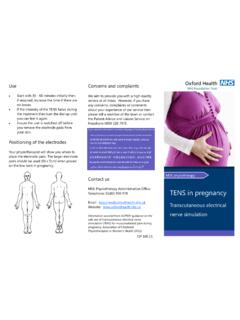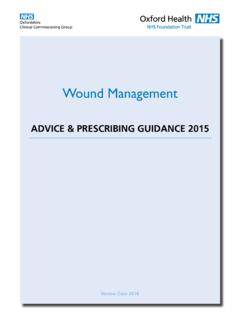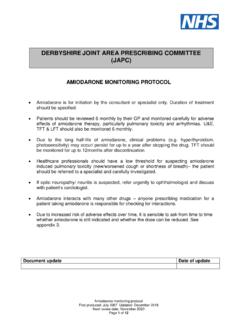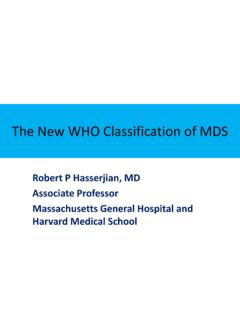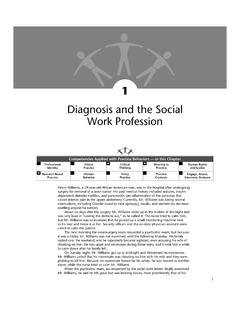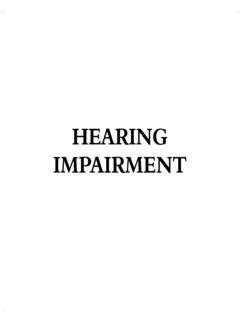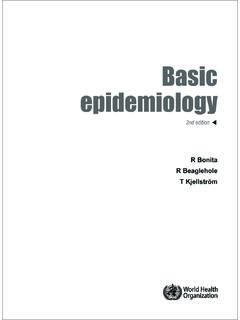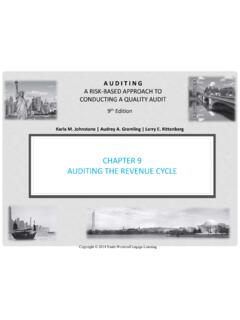Transcription of Assessment, diagnosis and management of leg ulcers
1 assessment , diagnosis and management of leg ulcersSarah Gardner, Clinical lead, Tissue viability serviceWhat are the challenges of leg ulcer management ?How do youfeel when a patient is referred with a leg ulcer?How do you think your patientfeels about their leg ulcer?Aim of the sessionTo develop a better understanding of the factors that contribute to the development of leg ulceration and how the application of proven treatments can improve clinical outcomesObjectives -}To gain a better understanding of the anatomy & Physiology of the vascular system}To understand the function of the veins and how venous incompetence can lead to skin breakdown}Be able to carry out a full holistic leg ulcer assessment in order to correctly diagnose the aetiology.}On diagnosis , be able to put an appropriate plan of care in place in order to support timely wound healing}Be able to differentiate between normal and abnormal ulceration and recognise when referral is ulcer training?
2 Why bother?}Hopefully you are here because you want to be}We have variable healing rates }LU assessment not always holistic }Bandaging challenges }Wounds that are constantly colonised and inflammatory}Wounds that are not progressing aren't always referred on in a timely way }Pain is difficult to manage}Co morbidities are sometimes seen in isolation to the woundExposed tendon Chronic ulceration .. what is effective leg ulcer management ?Arterial or venous???Skin condition or leg ulceration?Multiple wound ulcers over the local what do we do?When does trauma become leg ulceration?The tipping you will leave this training session and you will do things differently!Patient experience filmWhat is a leg ulcer?DefinitionA leg ulcer is a long-lasting (chronic) wound on your leg or foot that takes more than six weeks to choices, Venousleg ulcer is an open lesion between the knee and the ankle that remains unhealed for 4 weeks and occurs in the presence of venous disease.
3 (SIGN, 2010)Epidemiology of leg ulcers }Point Prevalence} per 1000 } per 1000 in older people (over 80)}Overall Prevalence}1%-2% (Oxford is )}Cost} 300- 600 million a year (Simon et al 2004).Causes/ aetiology}Venous disease = 70%}Arterial = 10- 15%}Mixed arterial & venous disease = 10 - 15 %The circulatory system Arteries carry oxygenated blood to your legs and the veins carry de-oxygenated blood away from your legs. The blood returns to the lungs to pick up more oxygen and returns to the heart to be pumped out again through the vesselsArteriesArteries take blood away from the heart and are the strongest blood vessels, as they have to withstand the pumping action of the heart. Arterial blood is charged with oxygen and nutrients for healthy tissues. Artery walls consist of three layers, the walls are more muscular and the lumen smaller enabling blood to travel at high pressure. Arteries branch into smaller vessels known as arterioles, which merge into vessels, no wider than a hair, which connect arteries to veins.
4 The exchange of gases (oxygen for carbon dioxide) occurs within the capillaries. A capillary wall is a semi permeable membrane and interstitial fluid moves continually between the blood capillary and the tissue. The rate of fluid leaking depends on several factors, including blood pressure in the blood capillaries and the concentration of plasma proteins in the tissue spaces.}Venules- When blood has left the tiny capillaries on its journey back to the heart, the vessels widen into venulesand then into the larger vessels known as These take blood back to the heart. Their walls are weaker than arteries and take impure blood back to the heart as oxygen has now been exchanged for carbon dioxide in the capillaries. Veins can be classed as superficial or deep. 10% of blood travels through the superficial veins, which are situated just beneath the skin. The remaining 90% of blood travels through deep veins, which are found closer to the bones in the leg and are surrounded and protected by various muscles.
5 These are the veins squeezed by the calf pump on contraction. Veins are also equipped with valvesto assist the flow of blood back to the heart. The valves in the veins open in one direction, therefore helping to prevent backflow of blood. When valves are working as they should, healthy veins are divided into compartments and this helps to relieve strain on the vessel -So called because they perforate the deep fascia of muscles, to connect the superficial veins to the deep veins where they drain. Their role is to maintain correct blood drainage. They have valves which prevent blood flowing back (reflux), from deep to superficial veins in muscular systemThis is a one-way drainage system that returns fluid to the vascular circulation via a network of lymphatic vessels and lymph nodes. Some lie deep within the body, others close to the lymphatic system has an important role to play in maintaining fluid balance, transporting fats and proteins and providing an immune main function of the lymphatics is to help the re -absorption of interstitial fluid into the blood circulation.
6 Normal balance is reached when fluid and waste products are removed from the tissues as quickly as they are produced. Increased capillary leakage can overwhelm the capacity of the lymphatics to drain the excess fluid, which can result in oedema. HEALTHY VENOUS FUNCTIONFor blood to be effectively taken against gravity back to the heart the body needs valves in the veins to prevent the backflow of bloodLeg UlcersFaulty valves}When the deep system has faulty valves (the valves do not close tightly allowing the blood to leak back down) changes can start to occur within the legs which can result in leg ulceration. This is known as venous VENOUS FUNCTION -Damaged valves are a predisposing factor not a cause for developing a leg ulcerLeg UlcersCapillary exchangeFluids flow out of a capillary at the upstream end near an arteriole and re - enters a capillary downstream near a venule. The direction of fluid movement across the capillary wall at any point depends on the difference between two opposing forces: blood pressure and osmotic pressure.
7 When the pressure in the venous system is high it will affect the does this result in venous disease/ ulceration?Progression of damageincompetent valves venous stasis (pooling)exacerbates high pressurevenous dilationtissue floodingintoxication and local Ischaemiavenous ulcerCEAP Classification of chronic venous disease}Clinical classificationC0: no visible or palpable signs of venous diseaseC1: telangiectasies or reticular veinsC2: varicose veinsC3: oedemaC4a: pigmentation or eczemaC4b: lipodermatosclerosis or athroph e blancheC5: healed venous ulcerC6: active venous ulcers : symptomatic, including ache, pain, tightness, skin irritation, heaviness, and muscle cramps, and other complaints attributable to venous dysfunctionA: AsymptomaticRisk factors for venous disease/ ulceration:}Hereditary}Age}Female sex}Obesity}Pregnancy}Prolonged standing}Greater height}Immobilisation}PMH DVTA rterial ulcers }Arterial insufficiencyrefers to poor blood circulation to the lower leg and foot and is most often due to atherosclerosis.
8 In atherosclerosis the arteries become narrowed from deposits of fatty substances in the arterial vessel walls, often due to high levels of circulating cholesterol and aggravated by smoking and high blood pressure (hypertension). The arteries fail to deliver oxygen and nutrients to the leg and foot resulting in tissue breakdown. PATHOLOGYI ncreased oxygen demandProgressive occlusionLeg UlcersRisk factors for arterial disease}Smoking}Diabetes}Obesity}High BP}High cholesterol}Increasing age}Family historyAssessment}For every 1 mistake for not knowing, 10 are made for not looking!! assessment }Obtaining a diagnosis can only be achieved with a robust leg ulcer assessment }A leg ulcer assessment , including a dopplerand/ or lower limb assessment should be carried out within 1 - 2 weeks of the patient presenting}Doppler is only an aid to diagnosis not the be all and end all .. LOOK AT THE LIMB WHAT DOES IT TELL YOU?
9 Assessing patients with leg ulceration}1 Patient assessment (Extrinsic factors)}2 Patient assessment (Intrinsic factors)}3 Lower limb assessment }4 Wound assessmentPatient assessment }What information do you need to obtain when you carry out a patient assessment ?}Why is this information important/ relevant?}From the case study you have in front of you, what information is relevant and why?}Is this information assisting your diagnosis ?}Do you require more information at this point?FeedbackPATIENT FACTORS (extrinsic & Intrinsic) }socio-economic factors}cultural and religious beliefs}hygiene / environment}mobility; activity levels}lifestyle choices smoking / drugs / alcohol}major life stressors}Occupation/ previous occupation}treatments (appropriateness)}isolation }health beliefs / belief in treatment}relationship with nurse}concordance levels}medicines, drug therapies}Full medical history }Anxiety & Depression score }Quality of Life assessment }Bloods}Medication }MUST/ BMI}BP}Co-morbidities diabetes, rheumatoid arthritis current status.
10 }Pain assessment / scoreClinical history indicators of possible venous involvement}DVT }Thrombophlebitis}Leg, Pelvis or foot Fractures}Vein surgery or Sclerotherapy}Obesity}Multiple pregnancies}H/O Pulmonary embolismClinical history indicators of possible arterial involvement}Intermittent Claudication}Ischemic rest pain}CVA}MI}TIA}Peripheral vascular disease}Smoker}Diabetes}Heart disease or surgery}Hypertension}Renal Disease84 yr old diabetic, COPD, renal weeks after commencing insulinPain assessment & managementPain Scale}(Taken from the Wong-Baker Faces Scale)Abbey Pain scale}For measurement of pain in people with dementia who cannot verbalise.}Focusses on: vocalisation (whimpering, groaning, crying)}Facial expression}Changes in body language}Behavioural change}Physiological change (Temp, pulse or BP)}Physical changes (Skin tears, pressure areas, contractures)What type of pain-Use descriptorsNeuropathic Pain}shooting }burning}tingling }stabbing }piercing }raw }pricking}throbbing}Pins and needles }dagger likeNociceptive Pain}dull }aching }tender }cramping}sore }twinge}hurt}uncomfortable }spasm}nagging }sicklyHyperalgesia and allodynia}Patients can get Hyperalgesia(Excruciating pain in the wound bed}Allodynia(Pain in the surrounding skin))







